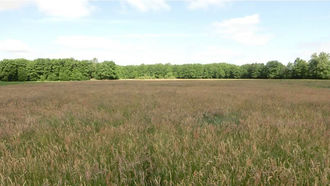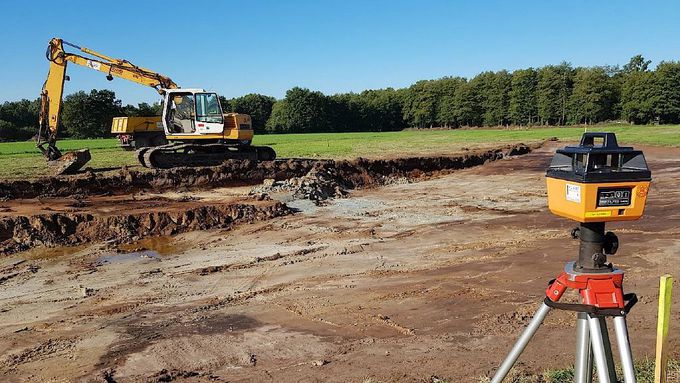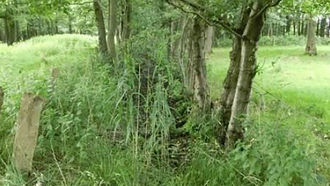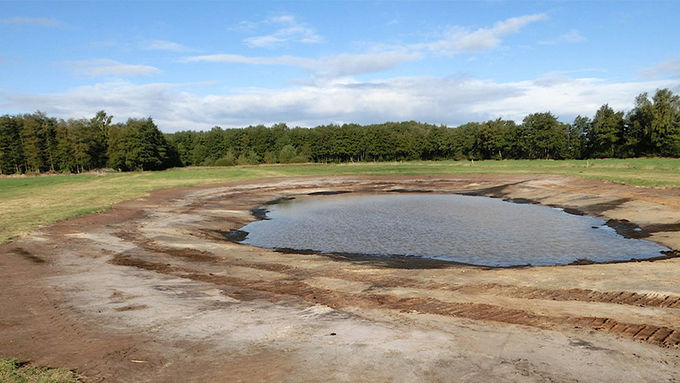The site before the action started (June 2017) © Hans-Gerhard Kulp, Biologische Station Osterholz
download picturemain content
Project of the month
#10/2018 A NEW CHANCE FOR THE FLOATING WATER-PLANTAIN
Construction of a waterbody in the nature reserve ‘Truper Blänken’
Only a hundred years ago, the ‘Truper Blänken’ were a paradise for many birds, dragonflies and amphibians. Before these deep pools were drained extensively starting from the 1930s, there had been a shallow water lake of more than 100 hectares. Its nutrient-poor water provided excellent conditions for a particular plant diversity. Many species of birds which are on the Red List of Endangered Species today were also existing in large numbers: apart from various duck species there were for example common snipes, curlews, black-tailed godwits and northern lapwings. With the enhancement of the former summer dike along the river Wümme the draining of the deep pools took place successively. Agriculture entered previously unused areas. This reduced the available habitat for the typical species to small residual water areas such as drainage channels. In the 1980s, only a few isolated occurrences of endangered plant species such as the floating water-plantain (Luronium natans), lesser marshwort (Helosciadium inundatum), gras-leaved pondweed (Potamogeton gramineus) and lesser water-plantain (Baldellia ranunculoides) remained. Therefore, in 1989, a 214 hectares large area was designated a nature reserve to preserve the remnants of the formerly extensive flood plain landscape which was characterized by still and flowing waters, reed and sedge beds, alder marsh forests and wetlands.
As part of the LIFE integrated project ‘Atlantic Region DE’ the creation of a shallow waterbody is intended to counteract the deficit of mesotrophic shallow waters which formerly had been characteristic of the ‘Truper Blänken’. Dr. Hans-Gerhard Kulp and Jonas Linke from the Biological Station Osterholz in cooperation with the District of Osterholz and the Lower Saxony Water Management, Coastal Defence and Nature Conservation Agency (NLWKN) had prepared a respective proposal within the framework of the cooperative site management. Apart from the creation of a waterbody of this habitat type which has become rare in the region, the conservation objective was particularly to resettle the floating water-plantain – one of the focus species of the LIFE IP – in this area.
Implementation and completion took place in September and early October 2018 under the construction supervision of the Biological Station Osterholz.
The main action was the construction of a shallow waterbody on a site owned by the Municipality of Lilienthal with a size of around 1,500 square metres. The new waterbody was shaped close to nature and fed by groundwater and rainwater. The excavated material was used outside of the conservation area.
Southwest of the area of activity was a former occurrence of the floating water-plantain, the lesser water-plantain and the lesser marshwort in a ditch. Meanwhile, the ditch had completely silted up and only consisted of a copse of alders. Under the given local conditions, the plant seeds which were still present were not able to germinate. Therefore, muddy material was removed from the ditch and transferred to the newly created waterbody. The sediment was put along the banks at a distance of about five metres.
Due to the favourable dry-warm weather, the construction of the waterbody was completed after only three days. The sediment extraction had to be implemented about two weeks later due to the stipulations formulated in the approval under the water laws.
In the next few years, the waterbody will be mapped by the Biological Station Osterholz as part of the area observation in terms of colonization with macrophytes and the vegetation of the zone between low and high water level. Random observations of amphibians and dragonflies will also be registered.
In the coming year, the completed works will also be presented to the inhabitants of Lilienthal as part of a public excursion.
Related topics
additional information
Further Links
- Biological Station Osterholz (in German) (external link opens in a new window)
- Nature reserve ‘Truper Blänken’ – Lower Saxony Water Management, Coastal Defence and Nature Conservation Agency (NLWKN) (in German) (external link opens in a new window)
- Information brochure ‘Nature reserve Truper Blänken’ – District of Osterholz (in German) (external link opens in a new window)







